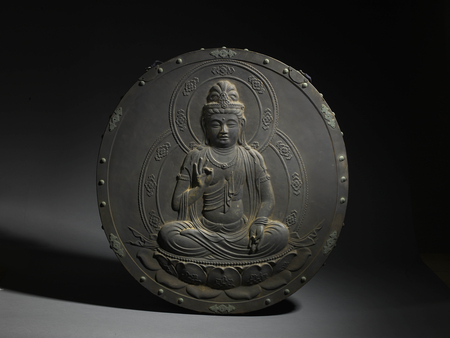Product Description
7287 A gilt kanshitsu (dry lacquer) kakebotoke (hanging plate with a Buddhist image) with a figure of Kannon Bosatsu seated in hanka za (half lotus position) on a lotus flower with the hands in an-i-in mudra. The head is adorned with a decorative crown at the base of a tall top-knot. Kannon is placed before a double mandorla with armlets and a necklace adorning the body
Japan 19th century Edo Period
Dimensions: H. 28½” x W. 27″ (72cm x 68.5cm)
This particular an-i-in mudra formed by the middle fingers and thumbs is called Lower Class: Middle Life. Lower class mudras are represented by the right hand raised to shoulder level and the left hand reposing on the left knee with palm upward. The circle formed by the thumb and middle finger, a complete form, having neither beginning nor end, is that of perfection and resembles the Law of Buddha, which is perfect and eternal.
Kakebotoke (hanging Buddha) are generally circular votive plaques symbolizing mirrors and adorned with repoussé or cast images most frequently of Buddhist deities. One of the few forms of Buddhist art unique to Japan, they can be found both at Shinto shrines and Buddhist temples and are presented as offerings to safeguard the compound and to ensure the prosperity of the Buddhist faith. In the Buddhist context they were hung from the eaves above the main entrance to an Image Hall, or above the frieze rail between the outer and inner sanctums of the shrine for the deity that protected the temple compound. They may also represent the actual hibutsu (hidden Buddha) which is not generally on show to the public.
Kannon Bodhisattva or Kannon Bosatsu is commonly known in English as the Goddess of Mercy represented as either male or female and depicted in many different forms and manifestations. Kannon’s worship originated in India during the 1st or 2nd century and later spread to the rest of Asia. Kannon is one of Asia’s most beloved deities and her worship remains non-denominational and widespread.
Kannon is a Bodhisattva and an active emanation of Amida Buddha, one who personifies compassion and achieves enlightenment but postpones Buddhahood until all can be saved. Her name first appears in the Lotus Sutra and means ‘One who Observes the Sounds of the World’. She can be worshipped independently as a saviour in almost all Buddhist sects including Esoteric Buddhism sects such as Zen, Nichiren, Tendai and Pure land Buddhism devoted to Amida.
For examples of kakebotoke see: Object as Insight, Japanese Buddhist Art and Ritual, Katonah Museum of Art, p. 46-47, pl. 9/10





